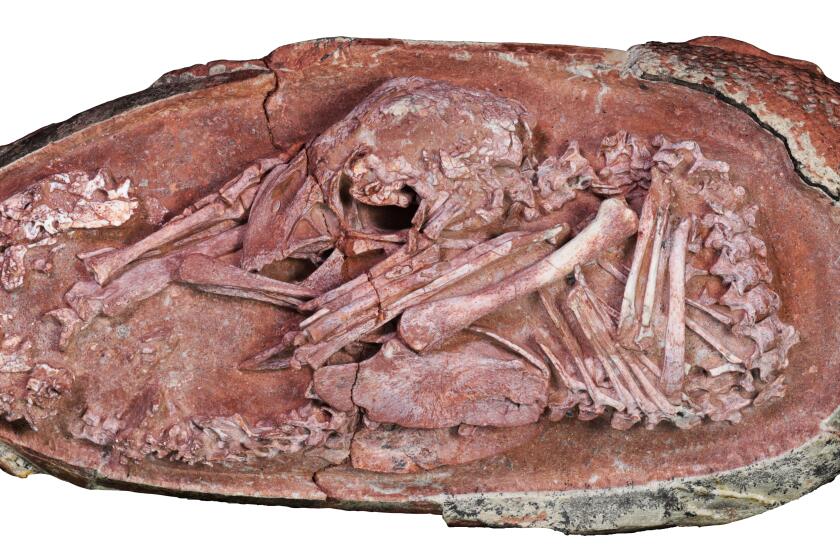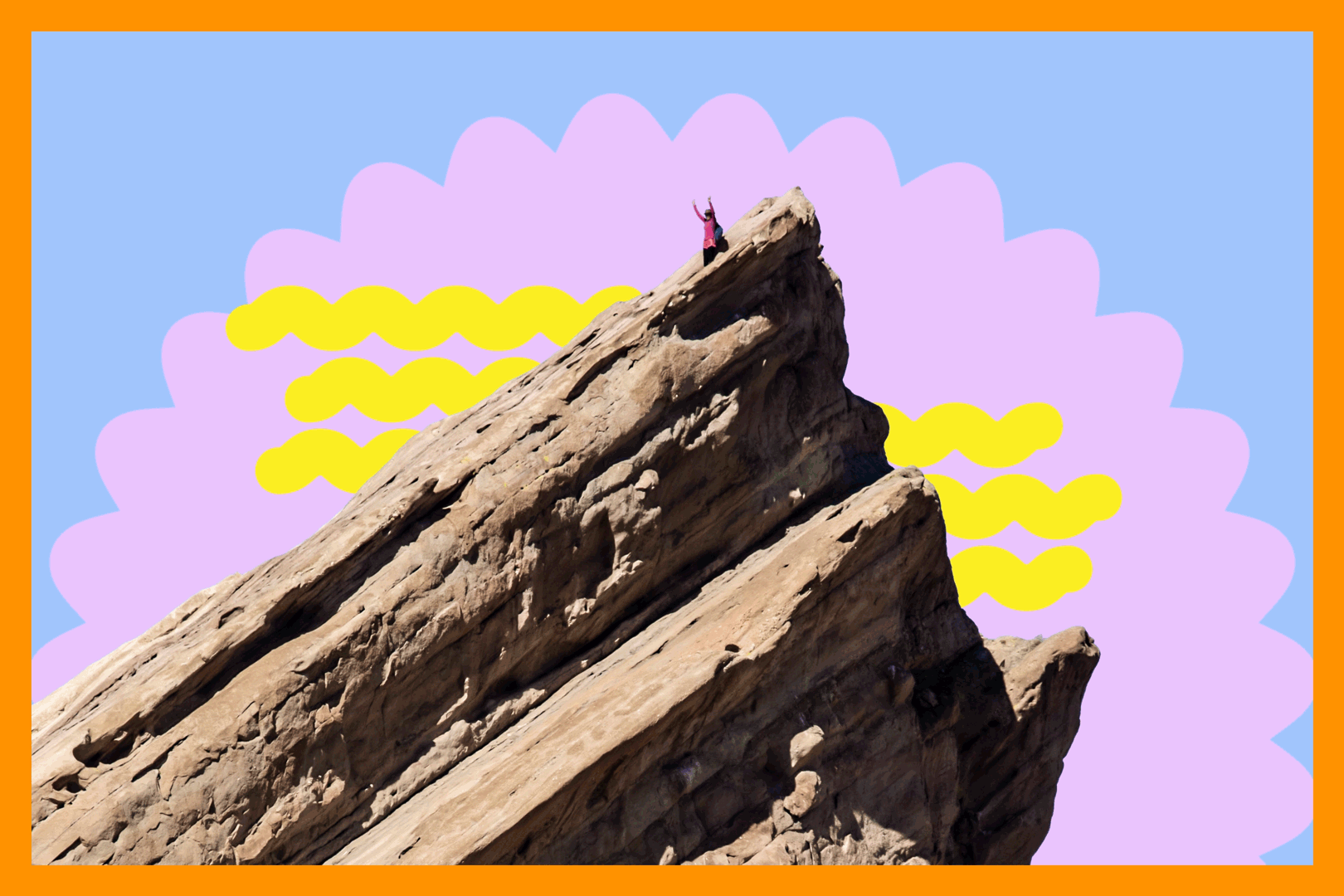Opinion: In a chaotic world, what can we learn from billion-year-old stones?

- Share via
Scrolling through Twitter one day very early in the COVID-19 pandemic, I saw a tweet that struck me as equal parts mirthless and true. “Things will be fine, eventually, in thousands of years, for rocks,” quipped comedian Donni Saphire. It reminded me of a saying my mother used to trot out when I was growing up, whenever I got exercised by some trivial contretemps or other — bad hair day, missed party, hallway snub. “In the grand scheme of things,” she would drawl, “it just doesn’t signify.”
This was patently untrue, of course, and irritating to boot. For the teenager, as for the toddler, there is no grand scheme of things; there is only the now, and it signifies absolutely.
For the record:
11:57 a.m. Oct. 11, 2024An earlier photo caption on this piece incorrectly stated that the Stone Wedding is believed to have begun forming 40 billion years ago.
Still: Everything will be fine, in the grand scheme of things, for rocks. In this era where we find ourselves locked in a perpetual calamitous stutter, teetering on the edge of catastrophe — why not try to imagine things from the unmoving, diamond-hard perspective of the mineral kingdom? It couldn’t hurt.
The embryo of an oviraptorosaur, perfectly preserved, is a reminder that our concept of “real time” is an illusion.
I’m not the first to suggest it. Poets have always used stones to convey the insensate, mute quality of the deceased. But in speaking of death, Emily Dickinson resorts to stone imagery more consistently, more creepily and more literally than perhaps any other poet in the English language. “’Twas Warm — at first — like Us,” for example, is a forensic description of a body in the process of rigor mortis, transmuting from person to thing: First the “Forehead copie[s] stone,” then the eyes congeal like a “Skater’s Brook,” until the body “drop[s] like Adamant” into the grave. The corpse’s “multiplied indifference” is given a more cheerful spin in “Safe in their Alabaster Chambers,” where Dickinson imagines the dead as so many “untouched” sleepers tucked safely in their stony beds.
Dickinson is fascinated by the imperviousness of stone, its uncomplaining persistence across the ages. “How happy is the little stone / That rambles in the road alone,” she writes. Of what possible significance is the span of a human life, she seems to ask, when measured against the vast swaths of uncounted and uncountable time at granite scale?
Among the side effects of the antidepressant drugs known as SSRIs — selective serotonin reuptake inhibitors — is what psychologists call “blunted” or “flattened affect,” a diminished range of emotive expression available to the patient. I have been on and off — mostly on — SSRI medication since my grad school-induced nervous breakdown and first depression diagnosis at the age of 24. In other words, for upward of 30 years.
When I first started taking the medication, it did not suppress my emotivity altogether but simply overrode its paralyzing force. I was no longer so panicked that I couldn’t leave the couch, nor so tearful that I couldn’t get out of bed. But as the years wore on, I noticed that I was, in fact, less apt to feel. Where once worry as to the fate of my soul (as a child) or my sanity (in my teens and 20s) had consumed me, with time I grew increasingly unable to feel any kind of way about the future, at least when it came to my own individual person. When I looked ahead, it was without any marked desire or apprehension — not unlike Dickinson’s stony sleepers, “Untouched by Morning / untouched by noon.”
To be fair: Even before the Prozac, I had not been given to passionate intensity, which was not my family’s predilection. Yet beyond whatever genetic tendency toward affectlessness I might have come by naturally, I believe Prozac had an additional numbing effect.
I used to think rocks were boring. Now I seek them out everywhere I go because of the stories they tell about our place in the universe.
The air of neutral indifference with which I appeared to approach my own life became a topic of medical curiosity when I was diagnosed with breast cancer in the fall of 2019. Among the many doctors I consulted was a psychiatrist appointed to check on how I was coping mentally with the prospect of mastectomy and chemotherapy. I rattled off my psychiatric history highlights while she nodded and scribbled notes. “But how do you feel?” she pressed. “I feel fine, really,” I kept repeating, smiling apologetically, aware that something in my response to the falling-apart of my own body was falling short of what she expected. When I read my clinical report afterward, I found this: “Patient seems to be speaking with some isolation of affect that is noticeable (discussing her diagnosis and sensitive topics with little to no emotional reactivity).”
A capacity for sensation, or what my doctor called “reactivity,” is among the oldest and most-trusted philosophical criteria by which to judge a creature’s place in the hierarchy of living things. Aristotle famously created a taxonomy of “souls” to describe an ascending biological scale: Vegetables were capable of growth and reproduction, which Aristotle called a “nutritive” soul. Animals, one notch up the ladder, exhibited the ensouled properties of plants and were additionally capable of feeling, motion and digestion. Finally, humans topped the chart as the only living beings endowed with a “rational soul,” or the capacity for thought. Minerals fell outside the scope of life altogether.
Reading the psychiatrist’s report, I saw myself slipping down the rungs of the Great Chain of Being: past the animal, past the vegetable, landing with an adamantine thud among the minerals.
Yet what if, like Dickinson, we could teach ourselves to entertain the possibility of a nonhuman scale — a geologic scale — as another way of looking at the world?
Dickinson fixates on stony, unfeeling death, yes. But she also employs the point of view of rocks to approximate certain interior mental states she experienced while still living, periods she felt to be a kind of death-in-life. In “After Great Pain,” Dickinson’s narrator describes a suspended state of frozen torpor that seizes her in the aftermath of grief. The narrator moves through life mechanically — “Regardless grown, / A Quartz contentment, like a stone.” In “It Was Not Death,” narrated from the point of view of what she calls chaos itself, “stopless” and “cool,” Dickinson conjures an inert, watery “void” before God created the form through which we recognize our human-centered world. Such impersonal mental states — quartz contentment, chaos cool — were clearly terrifying for Dickinson. But they were also instructive, apertures through which we might glimpse the world without us.
Minerals and living organisms are co-evolving, with the majority of today’s 5,000-plus documented mineral species a result, in one way or another, of the 3.8 billion years of biological activity on the planet. Some of the most baroquely beautiful crystals in existence, such as malachite, form through the oxidation of copper sulfide minerals; these crystals became a chemical possibility once the evolution of algal photosynthesis flooded the Earth’s atmosphere with oxygen 2 billion years ago. On the organic side of the equation, early invertebrates folded aragonite and calcite crystals from the ocean into their own metabolic cycles to build teeth, bone and shell.
When I told a friend about my incapacity for future-thinking or worry, he said, “Isn’t that just another name for wisdom?” “Wisdom literature” is, indeed, often touted as wise because it urges readers to ponder questions of scale, the transitory nature of any single life in the grand scheme of things.
Wisdom or chemical lobotomy, sagacity or brain deficit — who is to say? In the meantime, I am interested in what I might make of this peculiarly quartz-like lens.
To see like a stone, in Emily Dickinson’s sense, is not to turn a cold shoulder to the suffering of a sentient Earth. On the contrary: It is to sense those grand arcs that bind together the atoms of the cosmos, including — but no longer reduced to — our own species’ small, borrowed parcel of stardust.
Ellen Wayland-Smith is a professor in USC’s writing program and the author of the forthcoming “The Science of Last Things: Essays on Deep Times and the Boundaries of the Self,” from which this is adapted.
More to Read
A cure for the common opinion
Get thought-provoking perspectives with our weekly newsletter.
You may occasionally receive promotional content from the Los Angeles Times.












